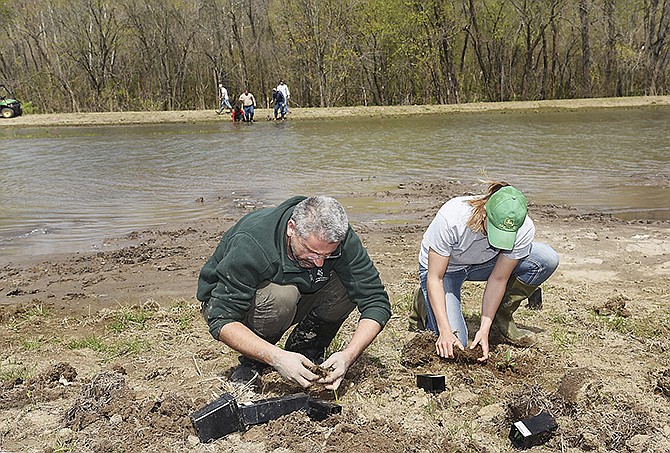Lincoln University's George Washington Carver Farm is establishing a wetland area on 12 acres of its property, bringing with it much of the biodiversity found in natural wetlands, including native plants and animals.
The project's primary purpose is educational: creating an outdoor classroom for LU students, farmers and eventually the public.
The developing wetland looks like a long, narrow pond. Water stretches about the length of seven football fields and is about 50 yards wide. The water ranges from a few inches deep to about 2½ feet at the deepest.
On Tuesday, about 20 students in LU's Agriculture Department and Wildlife Club pitched in to plant native Missouri grasses and plants, some in the water and some along the water's edge. They planted southern blue flag, arrowhead, pickerel weed, soft rush, marsh milkweed and other varieties.
Some of the plants serve to attract pollinators, including bees, butterflies, moths, flies and hummingbirds.
Ayriana Taylor, an LU junior, was one of the students helping to plant.
She pushed a soil corer into the ground, pulling up a chunk of soil to make room for a plant. "Look, I did it ... all by myself," she declared, as her smiling fellow students looked on.
Taylor came to LU thinking she would study to be a veterinarian, but her experiences at the university led her to transition into an animal science major.
"I came today because I thought it would be fun," she said. "I like getting dirty, and I get to learn some new stuff about plants."
Farm Superintendent Jeremia Markway said farm workers came up with the idea for a wetland after trying unsuccessfully to use the chunk of land, which is beside the Moreau River, for hay production and research.
The land is also beside the farm's aquaculture building that uses well water, which it then releases into a catch pond before it ultimately is filtered into the nearby Moreau.
"We got to thinking about what we could do that would help Lincoln out but also be something good for the public, a good demonstration of something positive environmentally, and we came up with a wetland," Markway said.
The wetlands will allow the farm to use the aquaculture water for another purpose and to control the water levels in the wetlands, simulating the natural ebb and flow of wetlands throughout the year.
The wetlands won't be open to the public at all times, but Markway hopes the farm can offer educational events, including tours for the public and school groups. It could also serve to show farmers the type of things that could be done with land that is marginal for planting, he said.
A 475-foot trail along one side of the wetland complex will be built for observation and education. The land also will be used for grazing at times.
Adrian Andrei, professor of wildlife science in LU's Department of Agriculture, said he plans to take almost all of the classes he teaches to the wetland complex.
"Wetlands host a great range of biological diversity, a lot of species," he said. "Another benefit is during flooding, they can store a lot of water. In many parts of the world, wetlands help to recharge aquifers. Wetlands, like this one, will also provide a rest stop for migratory birds."
More than 100 bird species come through the area each season, he said, adding they've already seen ducks and geese in the wetland complex in the past few months. No fish will be stocked in the water to encourage other species - including amphibians, reptiles and insects - to make their home there, Andrei said.
The majority of the project was funded through an EPA grant of about $36,000 that went through the Missouri Department of Natural Resources. Other contributors were the Missouri Department of Conservation, Ducks Unlimited, Three Rivers Electric Coop and Hamilton Native Outpost, a native seed company.
The Wetland Emphasis Team in Fulton designed the wetland complex.

